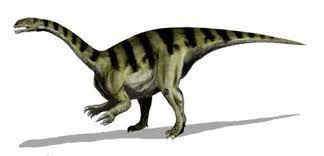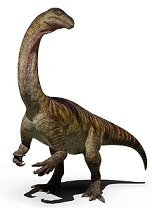
Sarahsaurus is a remarkable Dinosaur that provides valuable insights into the world of the Early Jurassic period, approximately 190 million years ago. Named after Sarah Butler, the daughter of one of its discoverers, this dinosaur belongs to the Sauropodomorpha clade and represents a pivotal stage in the evolution of long-necked dinosaurs, or sauropods. In this article, we will delve into the discovery, physical characteristics, habitat, and significance of Sarahsaurus in understanding the Earth's ancient past.
Sarahsaurus was discovered in the Kayenta Formation of Arizona, USA. The dinosaur was named Sarahsaurus aurifontanalis in honor of Sarah Butler and the Latin words aurum (gold) and fontanalis (of the fountain), referencing the region's geology.
| Name: | Sarahsaurus dinosaurs |
| Size: | Around 14 to 19 feet in length , 500 to 1,000 kilograms in weight. |
| Main Facts: | Sarahsaurus is a crucial transitional dinosaur, offering insights into sauropod evolution, with an intermediate physique between early forms and giants. |
Sarahsaurus inhabited a diverse and lush ecosystem during the Early Jurassic period. The Kayenta Formation in Arizona, where its fossils were found, was a region characterized by rivers, lakes, and abundant vegetation. This habitat supported a variety of plant and animal life, making it an ideal setting for a herbivorous dinosaur like Sarahsaurus.

Sarahsaurus was a moderately sized dinosaur, measuring around 14 to 19 feet in length and weighing an estimated 500 to 1,000 kilograms. It exhibited characteristics that bridge the gap between earlier, more primitive sauropodomorphs and the later, massive sauropods. Its body was relatively slender compared to its later relatives, with a long neck and tail.
One of the defining features of Sarahsaurus was its long neck, which suggests that it was a herbivore that fed on vegetation, likely plants and ferns. Its teeth were adapted for stripping leaves and other plant material, as opposed to the grinding teeth found in later sauropods.
Sarahsaurus holds a special place in the study of dinosaur evolution because it represents a transitional form between earlier, smaller sauropodomorphs and the colossal sauropods that dominated the Late Jurassic and Cretaceous periods. Its intermediate characteristics offer valuable insights into how these massive long-necked dinosaurs evolved over time.
Sarahsaurus, an Early Jurassic dinosaur found in Arizona's Kayenta Formation, measured approximately 14 to 19 feet in length and weighed about 500 to 1,000 kilograms. It bridged the gap between primitive sauropodomorphs and the massive sauropods, showcasing a moderately slender body with a long neck and tail. This herbivorous dinosaur's teeth were adapted for stripping leaves and plants.
Sarahsaurus is a critical transitional species, shedding light on the evolution of long-necked dinosaurs. It lived in a lush, riverine environment, providing insights into the ecosystems of the Early Jurassic period and the adaptations that allowed dinosaurs to thrive in different ecological niches.
Sarahsaurus lived during the Early Jurassic, which was marked by the emergence of diverse dinosaur lineages. Comparing it to contemporaneous dinosaurs helps us understand the ecosystems of that time.
Sarahsaurus is a sauropodomorph dinosaur, related to later sauropods. Comparisons with other sauropodomorphs reveal its evolutionary position within this group.
Sarahsaurus was a small dinosaur, growing to around 15 feet (4.5 meters) in length. This contrasts with the much larger sauropods that evolved later during the Jurassic and Cretaceous periods.
Sarahsaurus had adaptations for both bipedal and quadrupedal locomotion. Comparing its limb proportions to those of other dinosaurs helps us understand how these adaptations evolved.
Like other sauropodomorphs, Sarahsaurus was herbivorous. Comparisons with contemporary herbivorous dinosaurs reveal variations in feeding habits and adaptations.
Sarahsaurus fossils were found in North America, providing insights into the dinosaur fauna of this region during the Early Jurassic.
Sarahsaurus is considered an early member of the sauropodomorph lineage. Comparing its features to later sauropods and other dinosaurs helps us trace the evolution of these giants.
While difficult to determine from fossils, comparing Sarahsaurus to other dinosaurs can offer insights into its potential social behaviors, such as herding or solitary living.
Sarahsaurus lived during a time of significant environmental changes, and studying its extinction alongside other Early Jurassic dinosaurs helps us understand the factors influencing dinosaur survival and decline.